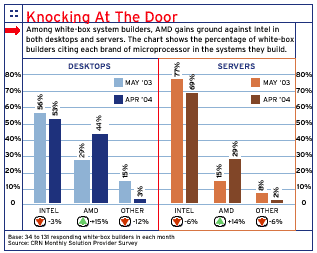AMD's 64-Bit Attack
Ruiz, who was handed the chairman post last month as a reward for progress made during his two-year tenure at Sunnyvale, Calif.-based AMD's helm, is upping the 64-bit ante on both the technology and channel fronts.
On the technology side, AMD is set this week to announce three faster 64-bit Opteron processors: the 850, primarily aimed at the high-end four-/eight-way system market; the 250, aimed at the two-way system market; and the 150, aimed at the single server market. All of the processors run at 2.4GHz, up from 2.2GHz. The 250 is available this week, while the 850 and 150 are expected to be available within 30 days.
On the channel front, AMD, which said it is already recruiting more than 2,000 new partners each quarter, is increasing its channel investment significantly this year, said Ruiz in an interview with CRN (see sidebar excerpts and full interview online).

\
Hector Ruiz, AMD Chairman, President and CEO
"They are a very precious part of our business," said Ruiz, referring to system builders and other channel partners. "We pay a lot of attention to [them]. We have a team that's totally dedicated,I would say roughly half of our sales and marketing effort is devoted to supporting this segment. So, by definition, I spend a significant amount of time making sure we continue to nurture and support this very important segment."
In the server market alone, AMD is aiming to double the number of its system builders this year to 1,000, up from 500. Exclusive CRN research shows the AMD push is gaining traction (see chart). Over the past year, the percentage of custom-system builders using AMD processors in the servers they build nearly doubled to 29 percent in April 2004, up from 15 percent in May 2003. The percentage of custom-system builders using Santa Clara, Calif.-based Intel's processors in their servers during this same period dropped 8 percentage points to 69 percent. AMD has made similar gains in the custom-system-builder desktop market.
Meanwhile, the percentage of solution providers saying they're satisfied with AMD's channel program increased to 51 percent in the first quarter, up from 42 percent in the fourth quarter of last year, according to CRN's Channel Satisfaction survey. The first-quarter figure is the highest mark AMD has received in more than a year.
One reason for that satisfaction is the price/performance of the AMD Opteron line, which is now being pushed hard and fast into the four-way market. Indeed, the 850 processor will help spark a new wave of aggressively priced four-way systems, including offerings from Angstrom Microsystems, Verari Systems, Rackable Systems, Appro and PSSC Labs.
AMD expects this four-way onslaught to drive mainstream four-way prices from about $10,000 to as low as $5,000 by the end of the year. That means more pressure on the old-line high-performance scientific workstation RISC offerings from vendors such as Sun Microsystems, Hewlett-Packard, IBM and Silicon Graphics. That may be one reason why both Sun and Hewlett-Packard have embraced Opteron.
Ben Williams, director of AMD's workstation server business, said the four-way price/performance breakthrough is a prime-time opportunity for white-box builders to target longtime rival Dell, the only major tier-one vendor without an Opteron product. "This is a way for system builders to have both two-way and four-way product lines based on Opteron to hit Dell right between the eyes," said Williams.
Dell, Round Rock, Texas, does not use AMD processors in any of its systems.


System builders say the four-way push is taking hold. "I am very happy to see the 850s and 250s come out," said Lalit Jain, CEO and president of Angstrom, an AMD Opteron specialist in Boston. "AMD is relentlessly pushing the limits of computing right now in the mainstream market. They have the lead in computing and they are extending it. Intel is playing catch-up."
Angstrom is offering its four-way Titan64 QuadraBlade server starting at less than $9,000 for an entry-level system. Jain expects that price to approach $5,000 in the first half of next year.
Jain, who stopped building Intel systems in 2002 and switched exclusively to AMD processors, said Intel simply has nothing that can match the Opteron's architecture and performance. That gamble on AMD, no small matter in 2002, has paid off, said Jain. In fact, he said sales doubled in 2003 and he expects them to double again this year.
Verari, a self-described "chip-agnostic" high-performance computer maker in San Diego that uses both AMD and Intel processors, has seen the share of its business devoted to AMD servers double to more than 40 percent since the launch of the Opteron more than a year ago. "Intel was dominating through 2002 and early 2003. That changed with the Opteron," said Verari CEO David Driggers. "AMD gave people what they wanted, which is choice, backward compatibility with the existing infrastructure."
Now, Verari is getting into the four-way game with systems that will support the 850 at prices starting in the $8,000 range for a blade system and $10,000 for a workstation version. And Driggers said he expects those prices to fall to $5,000 and $6,000, respectively, sometime in the first quarter next year.
"AMD is pricing Opterons to drive the four-way system market to be a volume play rather than a niche play," he said. "I think they will bring four-way computing into the mainstream."
And it's not just system builders that are adopting AMD four-way processors. HP, Intel's longtime partner in the development of the 64-bit Itanium (known by some AMD zealots as "Itanic"), has jumped on the Opteron bandwagon. HP, Palo Alto, Calif., has 1U rack-mount two-way servers for high-performance computing and midsize businesses, and standard four-way Opteron-based servers with full redundancy, said James Mouton, vice president of the Industry Standard Server group's Platform Division within HP. He said HP remains committed to the Intel road map and that the Opteron push is not at the "expense of our Intel portfolio."
HP is battling the system builders that are exploiting the AMD processor in the server segment. In the first quarter, custom-built systems overtook HP as the overall best-selling PC server for the first time in two years, according to CRN's Monthly Solution Provider Survey.
Sun, which launched its partnership with AMD last November, has already delivered a two-way Opteron-based server, the V20z. "It beats some Itanium machines with seven or eight times the price," boasts Rajesh Shakkarwar, product line director for Sun's x86 entry server line. He said Sun, Santa Clara, also plans to offer Opteron-based blade servers, four- and eight-way servers, and workstations.
Yet, Ruiz is far from satisfied with the gains his company has made. His aim now is nothing short of reshaping the market by driving four-way system pricing to a level that Intel simply cannot match. Indeed, AMD's intent, he said, is to "make a significant,not minor, but significant,change to the price/performance equation in the server space."
However, changing that equation is about to get a whole lot tougher for AMD. System builders say sleeping giant Intel, which with annual sales of $30.1 billion weighs in at nearly 10 times the size of AMD, suddenly appears to have recognized the AMD threat and is responding with full force.
In what system builders call a direct response to AMD, Intel said earlier this month that it was redrawing its development road map, scrapping its next-generation server and PC processors and accelerating the schedule for dual-core technology, i.e., two processors on a single chip. Intel now says it will move to dual-core processor technology in 2005. Although Intel publicly denies it, some system builders say the change was prompted by concerns regarding the heat dissipation characteristics of the Intel processors. Put simply, system builders say, the chips were running too hot.

Tom Barton, president and CEO of Rackable, which builds systems using both AMD and Intel processors, said the sudden shift is a sign the company is taking the power consumption concerns and the Opteron threat seriously. At Rackable, AMD-based systems have become a "significant fraction" of Rackable's revenue stream in the wake of the popularity of the Opteron, said Barton. He said he expected Opteron to appeal to the high-performance computing market, but was "surprised" by the processor's broad appeal in the Web application server market. "Opteron is taking share from the high-end Xeons," he said. "It's not competing with Itanium."
The big question now is whether AMD will accelerate its road map for dual-core technology. Before the Intel shift, Ruiz told CRN that AMD will move to a dual-core product beginning next year, saying the technology road map is "clearly aggressive and intense as you look ahead."
Intel President and COO Paul Otellini acknowledged last week during the company's analyst meeting that AMD has gotten Intel's attention as vendors have added Opteron to their product lineups. "If anything, it raises our competitive juices to go win that business back," he said. Besides its dual-core shift, Intel is fighting back by introducing 64-bit extensions to its Xeon line. Intel is also flexing its muscle in the notebook segment. Just last week, the company launched three new mobile Pentium processors (the 2GHz Pentium M755, the 1.8GHz Pentium M745 and the 1.7GHz Pentium M735) along with a new naming convention for mobile and desktop processors designed to highlight capabilities beyond standard GHz power.
AMD is also stepping up its mobile march, using the same 64-/32-bit compatibility strategy that has won it acclaim in servers. Ruiz said that in the second half his company will ship new Athlon mobile chips aimed at road warriors. The mobile effort is all part of a massive push to keep the engineering heat on Intel.
"AMD has a tremendous amount of momentum," said Anthony Kenisky, director of sales at Appro, a high-performance computer maker in Milpitas, Calif., which uses Intel and AMD chips and has seen a shift toward AMD in the past year. "They certainly have come a long way in a short period of time." Of course, he cautions, Intel has a tremendous amount of R&D and channel muscle. At the end of the day, he said, the processor war between the two means a more powerful price/performance proposition for system builders and their customers.
"It's good to see the competition," he said.
EDWARD F. MOLTZEN contributed to this story.